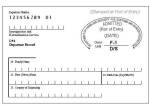 On March 21, 2013, the Customs and Border Protection agency (CBP) announced that it submitted a new rule to the Federal Register that all Forms I-94 will become automated. Please see below the CBP press release copied from their website for ease of reference.
On March 21, 2013, the Customs and Border Protection agency (CBP) announced that it submitted a new rule to the Federal Register that all Forms I-94 will become automated. Please see below the CBP press release copied from their website for ease of reference.
What is Form I-94?
The I-94 Form is the record of Arrival and Departure to the United States. The document is evidence of lawful entry/admission in the US for any foreign national whether they are visiting or working.
Generally, a form is given out (from what I remember during my visiting days!) in the airplane before landing. One would submit the form during the immigration inspection at the airport. The shorter section would be torn and stapled to the traveler’s passport (see photo).
What the new rules mean:
A year or two ago, CBP introduced ESTA –Electronic System for Travel Authorization. ESTA requires visiting travelers from visa waiver countries to complete certain information online in advance of traveling. The information allows travel authorization valid for two years. The new system eliminated the necessecity to have an I-94 for these particular travelers. Instead, visa waiver travelers get a stamp in their passports with the annotation of ‘WT’ or ‘waiver traveler’.
The new rules will, it seems, do the same thing. No paper record will be given to the traveler. Instead, there will be an electronic version of the I-94 on the CBP database. This can be printed at www.cbp.gov if and when needed. It is hoped that the new rules will streamline the process and reduce costs.
Why is it important?
The I-94 is an extremely important document. I never appreciated its importance when I used to travel to the US time when I-94’s applied to waiver travelers. It proves that one arrived legally into the US and was ‘inspected’ or seen and interviewed by an immigration officer. This document is then used in any immigration petition, whether family-based or employment-based. For example, if you are a visitor and are now changing status to ‘adjust’ or get a green card, you will need this. If you are a work visa holder, be it L, H, O, E or anything else, you too will need this.
A benefit I can see is this: currently, when an I-94 is lost, one must file a form with appropriate filing fees to obtain a replacement I-94 card, which can take a few months to obtain. When the new rules go into effect, there will be no chance of losing one’s card as it is likely to be available to print anytime multiple times.
How will this affect you?
If you will be filing an immigration petition, the procedures will not change for USCIS. You will now need to take an additional step of visiting www.cbp.gov. You will enter your details, find your I-94 record and then print for submission with your application.
In my opinion, it may be safer to print it anyway and keep in your passport as it is done these days, just to prove your status in the event you need evidence of it. As this becomes practice in the coming months, we will learn what works and what doesn’t. I will be sure to share my thoughts in due course.
___________________________
“CBP Announces Automation of Form I-94 Arrival/Departure Record
Eliminates Paper Forms, Streamlines Admission Process
(Thursday, March 21, 2013)
Washington — U.S. Customs and Border Protection today announced that it has submitted to the Federal Register a rule that will automate Form I-94 Arrival/Departure Record to streamline the admissions process for individuals lawfully visiting the United States. Form I-94 provides international visitors evidence they have been lawfully admitted to the U.S. which is necessary to verify alien registration, immigration status, and employment authorization. The automation means that affected visitors will no longer need to fill out a paper form when arriving to the U.S. by air or sea, improving procedures and reducing costs. The change will go into effect 30 days after the rule is published in the Federal Register.
“Automation of the I-94 will increase efficiency and streamline the admission process,” said CBP Deputy Commissioner David V. Aguilar. “Once fully implemented, the process will facilitate security and travel while saving CBP an estimated $15.5 million a year.”
Travelers wanting a hard copy or other evidence of admission will be directed to www.cbp.gov/I94* to print a copy of an I-94 based on the electronically submitted data, including the I-94 number from the form, to provide as necessary to benefits providers or as evidence of lawful admission. ( www.cbp.gov/I94 )
As part of CBP’s work to bring advances in technology and automation to the passenger processing environment, records of admission will now be generated using traveler information already transmitted through electronic means. This change should decrease paperwork for both the officer and the traveler and will allow CBP to better optimize its resources.
*The www.cbp.gov/i94 website will be live 30 days after the rule is published to the Federal Register. ( www.cbp.gov/I94 )”

One thought on “Paperless I-94? What You Need to Know!”
Comments are closed.